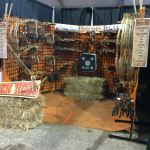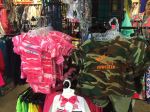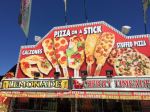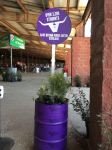This New York Times piece about rodeo came out when I was out at the rodeo, which was not only great timing, but also very interesting and informative. It’s all coming up ‘rodeo’ at the moment….
myth of cowboy
Images of ‘Cowboy Culture’
What a fantastic research trip to the Rodeo! I’m still sorting through data, reflecting, coding, analyzing, etc. etc. So, watch this space… However, if you’re interested, here’s a link to some of the photos that make up my visual ethnography:
So far, I’ve coded them into five main themes: animals, food, landscape (includes sub-themes: marketing and sponsorship), merchandise, people.
- Texas Longhorn
- Willie Nelson
- Rodeo Beauty Queens
- Interesting cowboy boots
- Cross-bow and weaponry stall
- Baby clothes for sale
- Mexican merchandise
- Lots of food products on sticks
- Youth education is big part of Rodeo Austin brand
- Ram (sponsor) monster truck
- Branded ferris wheel
- Bull rider
(Real) Cowboy Up!
Along with issues of gender identity, I’m also interested in ethnicity and rodeo, especially given America’s somewhat complicated relationship with multiculturalism and so-called race relations. Preliminary secondary research is showing that there is a lot of segregation in rodeo events and performances. I suppose I shouldn’t be surprised, as events reflect broader societal norms for the most part, but I guess it’s disappointing to see such segregation in this day and age. There’s professional rodeo, which appears to be mainly white men; gay rodeo; women’s rodeo; Native American/Indian rodeo; African-American rodeo; Black rodeo; ‘Cowboys of Color‘; Charreada/Mexican rodeo; Disabled rodeo. It’s almost tribal. Historically, the ‘Wild West’ was a lot more diverse and integrated than rodeo presents it.
I spoke to two friends living in the American West, and they did not seem surprised at all by the multitude of factions in rodeo. It seems to be par for the course. Basically, from my understanding of the situation, the ethnically-focused groups were established as a reaction to the dominance of the white heterosexual male being presented as the ‘real’ cowboys. Interviews with African-American cowboy and rodeo associations bring up the ‘forgotten history’ and ‘lost heritage’ of Black cowboys, who were vital in settling the West.
The myth of the cowboy is very much linked to the rise of segregation and anti-immigration sentiment, which diminished the role of the non-white male in ‘building’ America. The invented tradition of the West has social, political, and moral significance, which has been reinforced by contemporary popular culture and media. Think of a cowboy. Silent, alone on his horse, independent, free to roam. Who comes to mind? John Wayne, Clint Eastwood, Gary Cooper, Jack Palance, Alan Ladd (Shane), Clayton Moore (Lone Ranger), Robert Redford, Sam Elliott, the Marlboro Man. Spaghetti Westerns have a lot to account for in constructing the concept of ‘cowboy’ in the popular imagination, it seems. Only in the past decades have marginalised groups started to assert their place and status in the ‘Wild West’ narrative.
A friend in Denver and I were discussing the idea of ‘legitimacy’ and ‘authenticity’ with regard to cowboy culture, which then manifests itself in public performances at rodeos. Authenticity is a complex term, imbued with meaning from those who construct it, given to multiple interpretations and narratives. It appears that authenticity in this case is established by constructing an identity based on ‘othering’ to legitimise yourself.
There appears to be an insecurity among cowboys about ‘infiltration’ from non-real cowboys. This has been exacerbated by a proliferation of rich retirees buying ranches, which has brought skepticism particularly to California cowboys. Has the desire to protect cowboying from fake cowboys translated into racism and homophobia?
Legitimacy of cowboys seems to be defined by beef and bourbon (gout?) and a particular construction of what is and is not ‘real’. It’s not about material culture necessarily – wearing a hat, boots, and gun doesn’t make you a cowboy. Any ‘imposter’ can buy their way into looking like a cowboy.
You have to be tough to take part in some rodeo sports. But how can ‘tough’ be defined by gender, sexuality, ethnicity? Isn’t the act of participating legitimacy enough?
Who is the real cowboy? Is it even a ‘boy’? Why does it matter?
Rodeo Research
The first thing I tell my students when they are embarking on research is to make sure they have the who, what, where, how, and why of their project clearly set out. Therefore, I think it’s only proper that I start out my research process this way too.
Who: The research focuses on stakeholders (performers, sponsors, vendors, organisers) and audiences; thus, both producers and consumers of the event.
What: This research explores the role of a heritage and sporting event as a mechanism which reinforces or challenges the reproduction of male-dominated heteronormative narratives in sport participation. Certain dominant groups often define ‘what sport is’ or ‘what sport should be like’ and how it is actually experienced by various groups within various cultural contexts. Perceptions of women and LGBTQ athletes, especially those who participate in violent or traditionally ‘macho’ sport, are socially constructed within culture.
By focusing on the case study of the Star of Texas Fair and Rodeo, this research aims to: 1) examine gendered power relations and interactions to understand the effectiveness of masculinities in the legitimation of the gender order in this event landscape; and, 2) critically evaluate commercialised elements such as merchandise, branding materials, and marketing to audiences to discern if the literal selling of this cowboy ideal has an impact on normalising masculine dominance, especially in a family entertainment setting.
Where: Star of Texas Fair and Rodeo, Austin, TX, USA.
How: Post-structural intersectional approaches. Qualitative research methods include semi-structured interviews with key stakeholders and ethnography via participant (as an attendee) observation.
Why: It is suggested that there are gaps in the literature regarding the gendering of event spaces, and this research aims to contribute to the body of knowledge in this area by exploring the constructions and commodification of masculinity in rodeo spaces.











